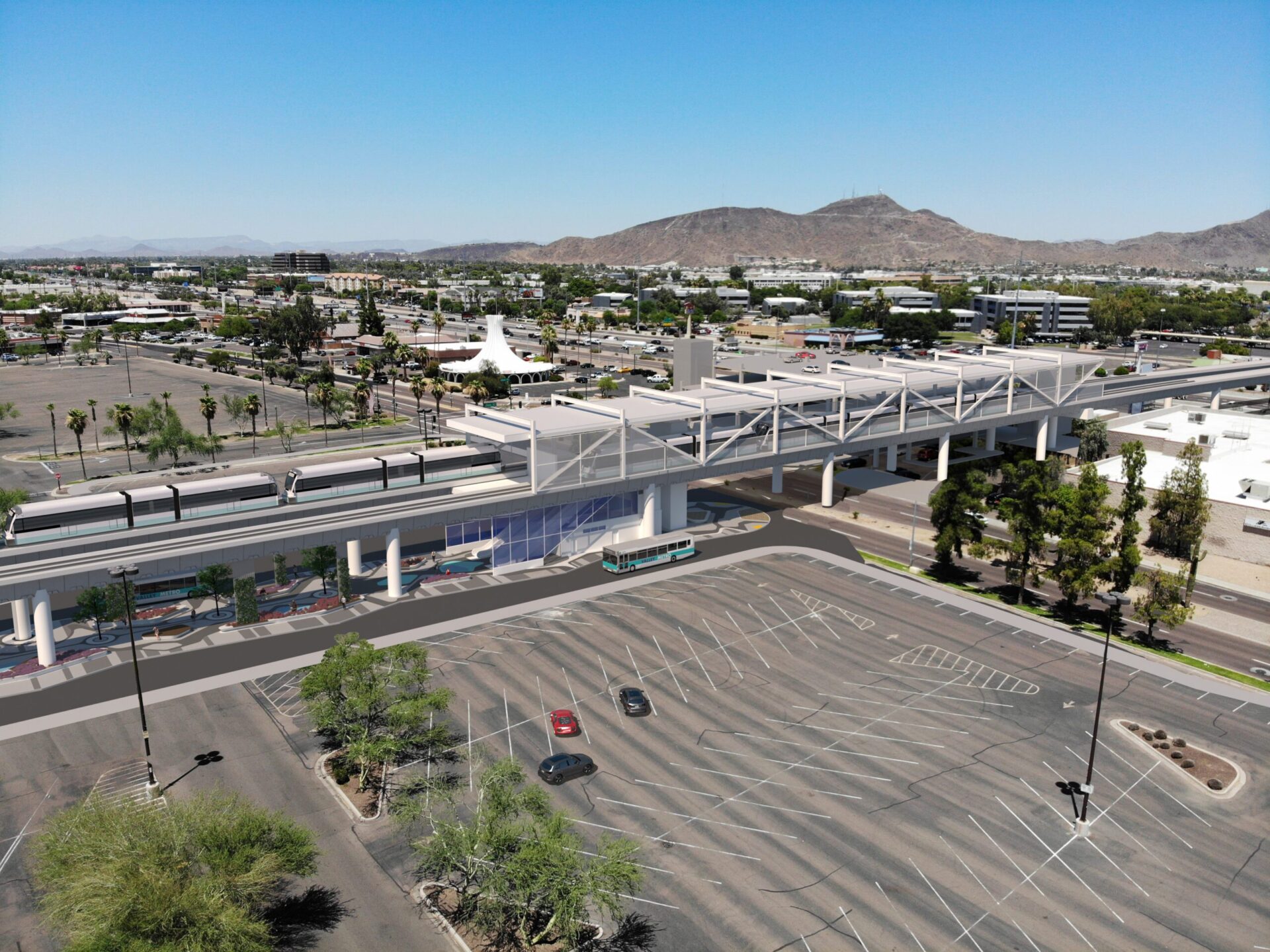
Location Phoenix, AZ
Client The Valley Metro Regional Public Transportation Authority (Valley Metro)
Services Construction Management, Program Management, Project Management
Project Value $281 Million
The Northwest Extension Phase II project comprised a 1.6-mile light rail extension in northwestern Phoenix, AZ. Featuring three new stations, the alignment runs west at-grade from the intersection of Dunlap Avenue and 19th Avenue, then north on 25th Avenue. An elevated guideway crosses Interstate 17 (I-17) at Mountain View Road, and the extension ends at a new aerial station on the west side of the freeway near the former Metrocenter Mall. Each new station features a community-oriented art installation. Additionally, the project included a series of firsts for Valley Metro and the City of Phoenix: the city’s first elevated light rail station, its first rail-only bridge over I-17, Valley Metro’s first four-story parking garage, the agency’s first use of steel fiber-reinforced concrete throughout a guideway, and Phoenix’s first multi-modal transit center, named after regional transit champion, former mayor, and former councilmember Thelda Williams.
Design began in the summer of 2018, and the project concluded on January 27, 2024—one year ahead of its anticipated 2025 opening. In addition to federal grants, the $281 million project was funded through the Transportation 2050 initiative’s 0.7 percent sales tax and Maricopa County’s Proposition 400, a 20-year extension of the region’s existing half-cent sales tax. With more than $6.5 million in remaining contingency funds, the project finished 2.3% under budget. The new segment is expected to service 1,400 new daily riders and brings the total length of Valley Metro’s rail system to 30 miles. Passengers can now use Valley Metro’s light rail system to access new destinations in northwest Phoenix and the West Valley region from Mesa, Tempe, and downtown Phoenix.
Valley Metro implemented a combination of the Construction Manager-at-Risk (CMAR) and design-build delivery methods on the project. This unique approach enabled the transit authority to achieve schedule and cost efficiencies, as well as a favorable risk profile. CMAR allowed the project team to collaborate on the complex task of designing the light rail expansion, locating and designing each station and traction power substation, and identifying how best to cross the I-17 freeway, while design-build was suited to the parking garage’s more standardized design and construction process.
Through an on-call contract providing program and construction management services on projects throughout Valley Metro’s ongoing expansion program, Hill managed the construction of the Northwest Extension Phase II project. The Hill team’s responsibilities included facilitating communications among Valley Metro’s project team, the City of Phoenix, the Arizona Department of Transportation, Maricopa County Flood Control District, and numerous third-party utilities. This included leading weekly progress meetings to promote timely information transfer, discuss progress, and collaborate on solutions to challenges. In addition to coordination and communications, Hill provided cost management, schedule management, and quality assurance. These services helped Valley Metro assemble and maintain a strong project team, develop accurate estimates and a realistic master schedule, monitor the schedule and budget through design and construction, promote issue resolution, and deliver the project as envisioned.
The Hill team’s efforts were instrumental in helping Valley Metro overcome the project’s major challenges, such as schedule impacts from more than a dozen third-party utility relocations that were completed two years later than planned. Hill and Valley Metro held meetings with the utilities and the contractor to develop workarounds allowing each party to complete their work while minimizing impacts on other parties. These meetings led to daily or even hourly adjustments that helped the team recover from the delays and achieve project delivery on time and within budget.
In addition, Hill helped Valley Metro tell the story of communities along the new alignment through art installations at each station. Hill’s public art coordinator worked with the artists and their teams, Valley Metro, and the contractor to coordinate the installation of the artwork within the contractor’s overall project schedule. In this way, Hill made certain the art was commissioned and installed safely, on time, and within budget.
Photos credit: Valley Metro